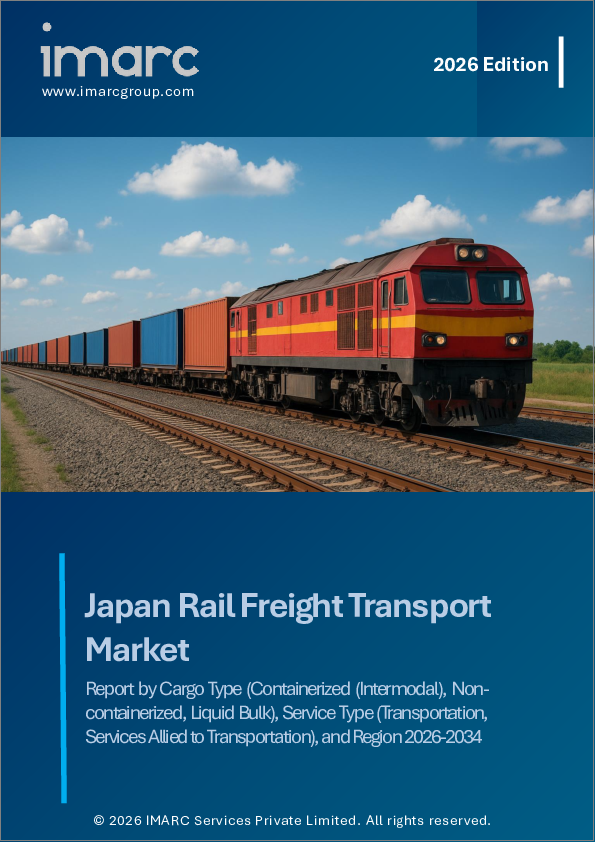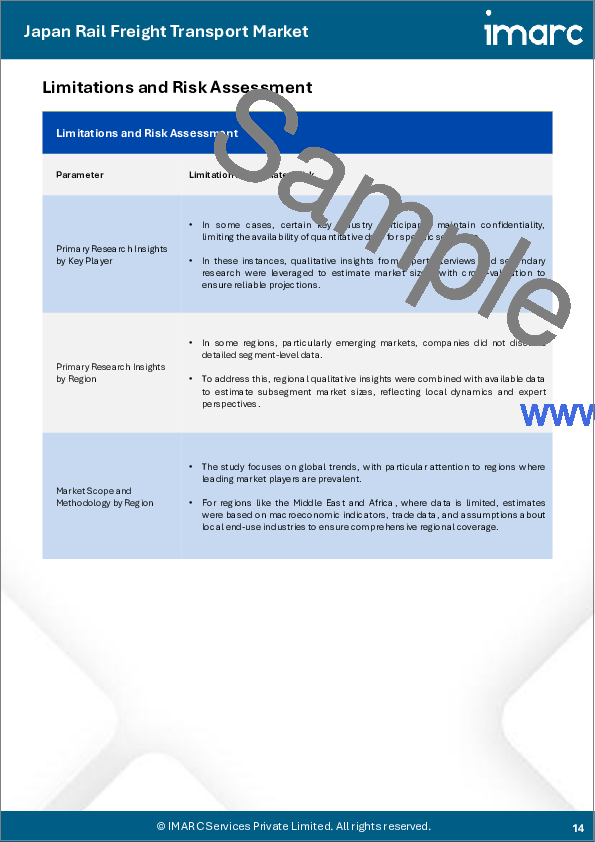|
|
市場調査レポート
商品コード
1729548
日本の鉄道貨物輸送市場レポート:貨物タイプ、サービスタイプ、地域別、2025年~2033年Japan Rail Freight Transport Market Report by Cargo Type (Containerized (Intermodal), Non-containerized, Liquid Bulk), Service Type (Transportation, Services Allied to Transportation), and Region 2025-2033 |
||||||
カスタマイズ可能
|
|||||||
| 日本の鉄道貨物輸送市場レポート:貨物タイプ、サービスタイプ、地域別、2025年~2033年 |
|
出版日: 2025年05月01日
発行: IMARC
ページ情報: 英文 120 Pages
納期: 5~7営業日
|
全表示
- 概要
- 目次
日本の鉄道貨物輸送の市場規模は2024年に166億トンKmに達しました。IMARCグループは、2025年から2033年にかけての成長率(CAGR)は2.7%で、2033年には215億トンキロに達すると予測しています。鉄道貨物輸送の効率、安全性、競合を改善することができる、より燃費の良い機関車、高度な追跡・監視システム、自動化など、鉄道技術における技術革新の高まりが、主に市場を牽引しています。
本レポートで扱う主な質問
- 日本の鉄道貨物輸送市場はこれまでどのように推移し、今後どのように推移するのか?
- COVID-19が日本の鉄道貨物輸送市場に与えた影響は?
- 日本の鉄道貨物輸送市場の貨物タイプ別区分は?
- 日本の鉄道貨物輸送市場のサービスタイプ別区分は?
- 日本の鉄道貨物輸送市場のバリューチェーンにおける様々なステージとは?
- 日本の鉄道貨物輸送の主な促進要因と課題は何か?
- 日本の鉄道貨物輸送市場の構造と主要プレーヤーは?
- 日本の鉄道貨物輸送市場における競合の程度は?
目次
第1章 序文
第2章 調査範囲と調査手法
- 調査の目的
- ステークホルダー
- データソース
- 市場推定
- 調査手法
第3章 エグゼクティブサマリー
第4章 日本の鉄道貨物輸送市場:イントロダクション
- 概要
- 市場力学
- 業界動向
- 競合情報
第5章 日本の鉄道貨物輸送市場情勢
- 過去および現在の市場動向(2019~2024年)
- 市場予測(2025~2033年)
第6章 日本の鉄道貨物輸送市場:貨物タイプ別の内訳
- コンテナ輸送(インターモーダル)
- 非コンテナ
- 液体バルク
第7章 日本の鉄道貨物輸送市場:サービスタイプ別の内訳
- 輸送機関
- 輸送関連サービス
第8章 日本の鉄道貨物輸送市場:競合情勢
- 概要
- 市場構造
- 市場企業のポジショニング
- 主要成功戦略
- 競合ダッシュボード
- 企業評価象限
第9章 主要企業のプロファイル
第10章 日本の鉄道貨物輸送市場:業界分析
- 促進要因、抑制要因、機会
- ポーターのファイブフォース分析
- バリューチェーン分析
第11章 付録
Japan rail freight transport market size reached 16.6 Billion Tonne Km in 2024. Looking forward, IMARC Group expects the market to reach 21.5 Billion Tonne Km by 2033, exhibiting a growth rate (CAGR) of 2.7% during 2025-2033. The escalating innovations in rail technology, such as more fuel-efficient locomotives, advanced tracking and monitoring systems, automation, etc., which can improve the efficiency, safety, and competitiveness of rail freight transport are primarily driving the market.
Rail freight transport, also known as rail cargo or rail shipping, is a mode of transporting goods and commodities using specially designed trains on dedicated rail tracks. It plays a vital role in the regional transportation industry, offering a cost-effective and efficient means of moving huge quantities of goods over long distances. Rail freight transport involves the loading of goods into freight cars, which come in various types to accommodate different cargo types, such as containers, bulk materials, and liquid tankers. These freight cars are then hauled by locomotives along established rail networks. Advantages of rail freight transport include its ability to carry heavy and bulky loads, lower carbon emissions compared to road transport, and reduced traffic congestion. It is particularly well-suited for long-haul transportation of raw materials, finished products, and bulk commodities, such as coal, grain, and chemicals. Despite facing competition from other modes of transportation, rail freight remains a crucial component of the global supply chain, supporting industries like manufacturing, agriculture, and energy production. It continues to evolve with technological advancements to improve efficiency and sustainability.
Japan Rail Freight Transport Market Trends:
The rail freight transport market in Japan is experiencing significant growth, primarily driven by several key factors. To begin with, the growing demand for sustainable transportation solutions has played a pivotal role. As concerns about carbon emissions and environmental sustainability continue to mount, businesses and governments alike are turning to rail as a cleaner, more eco-friendly alternative to long-haul trucking. Additionally, the ever-expanding e-commerce sector has contributed to the rise in rail freight, with the need for efficient and cost-effective logistics solutions becoming increasingly critical. Furthermore, the ongoing expansion of regional trade has boosted rail freight's importance as a reliable and cost-efficient means of moving goods across vast distances. Apart from this, infrastructure investments have played a crucial role in supporting the rail freight market's growth. Furthermore, the integration of digital technologies and data analytics, which enhance the efficiency and transparency of rail freight operations, making it more competitive and appealing to businesses, is expected to drive the market in Japan.
Japan Rail Freight Transport Market Segmentation:
Cargo Type Insights:
- Containerized (Intermodal)
- Non-containerized
- Liquid Bulk
Service Type Insights:
- Transportation
- Services Allied to Transportation
Competitive Landscape:
The market research report has also provided a comprehensive analysis of the competitive landscape in the market. Competitive analysis such as market structure, key player positioning, top winning strategies, competitive dashboard, and company evaluation quadrant has been covered in the report. Also, detailed profiles of all major companies have been provided.
Key Questions Answered in This Report:
- How has the Japan rail freight transport market performed so far and how will it perform in the coming years?
- What has been the impact of COVID-19 on the Japan rail freight transport market?
- What is the breakup of the Japan rail freight transport market on the basis of cargo type?
- What is the breakup of the Japan rail freight transport market on the basis of service type?
- What are the various stages in the value chain of the Japan rail freight transport market?
- What are the key driving factors and challenges in the Japan rail freight transport?
- What is the structure of the Japan rail freight tansport market and who are the key players?
- What is the degree of competition in the Japan rail freight transport market?
Table of Contents
1 Preface
2 Scope and Methodology
- 2.1 Objectives of the Study
- 2.2 Stakeholders
- 2.3 Data Sources
- 2.3.1 Primary Sources
- 2.3.2 Secondary Sources
- 2.4 Market Estimation
- 2.4.1 Bottom-Up Approach
- 2.4.2 Top-Down Approach
- 2.5 Forecasting Methodology
3 Executive Summary
4 Japan Rail Freight Transport Market - Introduction
- 4.1 Overview
- 4.2 Market Dynamics
- 4.3 Industry Trends
- 4.4 Competitive Intelligence
5 Japan Rail Freight Transport Market Landscape
- 5.1 Historical and Current Market Trends (2019-2024)
- 5.2 Market Forecast (2025-2033)
6 Japan Rail Freight Transport Market - Breakup by Cargo Type
- 6.1 Containerized (Intermodal)
- 6.1.1 Overview
- 6.1.2 Historical and Current Market Trends (2019-2024)
- 6.1.3 Market Forecast (2025-2033)
- 6.2 Non-containerized
- 6.2.1 Overview
- 6.2.2 Historical and Current Market Trends (2019-2024)
- 6.2.3 Market Forecast (2025-2033)
- 6.3 Liquid Bulk
- 6.3.1 Overview
- 6.3.2 Historical and Current Market Trends (2019-2024)
- 6.3.3 Market Forecast (2025-2033)
7 Japan Rail Freight Transport Market - Breakup by Service Type
- 7.1 Transportation
- 7.1.1 Overview
- 7.1.2 Historical and Current Market Trends (2019-2024)
- 7.1.3 Market Forecast (2025-2033)
- 7.2 Services Allied to Transportation
- 7.2.1 Overview
- 7.2.2 Historical and Current Market Trends (2019-2024)
- 7.2.3 Market Forecast (2025-2033)
8 Japan Rail Freight Transport Market - Competitive Landscape
- 8.1 Overview
- 8.2 Market Structure
- 8.3 Market Player Positioning
- 8.4 Top Winning Strategies
- 8.5 Competitive Dashboard
- 8.6 Company Evaluation Quadrant
9 Profiles of Key Players
- 9.1 Company A
- 9.1.1 Business Overview
- 9.1.2 Services Offered
- 9.1.3 Business Strategies
- 9.1.4 SWOT Analysis
- 9.1.5 Major News and Events
- 9.2 Company B
- 9.2.1 Business Overview
- 9.2.2 Services Offered
- 9.2.3 Business Strategies
- 9.2.4 SWOT Analysis
- 9.2.5 Major News and Events
- 9.3 Company C
- 9.3.1 Business Overview
- 9.3.2 Services Offered
- 9.3.3 Business Strategies
- 9.3.4 SWOT Analysis
- 9.3.5 Major News and Events
- 9.4 Company D
- 9.4.1 Business Overview
- 9.4.2 Services Offered
- 9.4.3 Business Strategies
- 9.4.4 SWOT Analysis
- 9.4.5 Major News and Events
- 9.5 Company E
- 9.5.1 Business Overview
- 9.5.2 Services Offered
- 9.5.3 Business Strategies
- 9.5.4 SWOT Analysis
- 9.5.5 Major News and Events
10 Japan Rail Freight Transport Market - Industry Analysis
- 10.1 Drivers, Restraints and Opportunities
- 10.1.1 Overview
- 10.1.2 Drivers
- 10.1.3 Restraints
- 10.1.4 Opportunities
- 10.2 Porters Five Forces Analysis
- 10.2.1 Overview
- 10.2.2 Bargaining Power of Buyers
- 10.2.3 Bargaining Power of Suppliers
- 10.2.4 Degree of Competition
- 10.2.5 Threat of New Entrants
- 10.2.6 Threat of Substitutes
- 10.3 Value Chain Analysis





